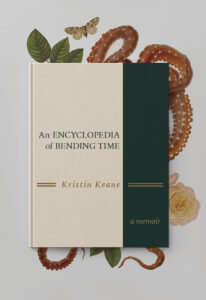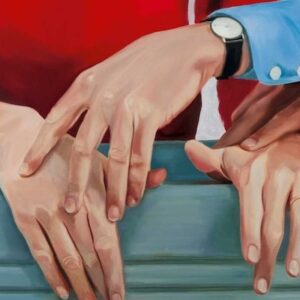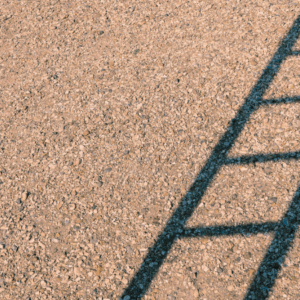
Some Notes on Time, Memory, and the Artifacts We Leave Behind
Kristin Keane: “I cannot keep the arrow from moving forward.”
ABSOLUTE TIME exists apart from observation. It can only be rendered through math, flowing through the universe at a scale at which externalities such as birth and death go unaccounted for. It is unforgiving. Astronomer and physicist Isaac Newton promoted the concept when he claimed in Philosophiae Naturalis Principia Mathematica, “All motions may be accelerated and retarded … but the flowing of absolute time is not liable to any change. The duration or perseverance of the existence of things remains the same, whether the motions are swift or slow, or none at all.” In contrast, relative time moves by way of our observation of change: the rotation of the Earth, the cycle of the moon.
I had never thought about time that way much before, but I understand now how the tide and it are the same, how they both ebb. When did we stand together at the sea’s edge? I’m not certain. Now, I try to count: my hands, your hands, our feet pressed into sand. Did we smile? Were the shells you collected all whole? How do I answer these questions?
Do you know what the edge of the water is called where it froths and washes everything away that is not stayed down? I can’t ask you anymore. It is a border, I know. A kind of fringe. There is so much there in its boundary, parts of animals and the sea pushed against the beach: you and me, now separated.
See also BEING; NEWTON, SIR ISAAC; MEMORIES; RETURNS; TIDES.
*
AFTERLIFE. Now, I turn to the familiar scripts of lives altered but returned: the VHS tapes we kept in the curio cabinet decades ago I watched as a child. Beetlejuice (1988), Pet Sematary (1989), Ghost (1990), and The Crow (1994) depict varying circumstances of life after death, and all rely on traditional story constructions to frame its possibilities: hauntings, longings, returns. In all four films, central characters become aware death has deprived them of the thing they once were. In the ‘90s, I watched these with strips of candy buttons and a remote control. They aim to display the gruesome artifacts of life’s end and the munificent hosts who carry protagonists through to meaningful understanding. Surely there is something here for me now inside their variance.
There might be a time again when I find you, a way to take the dots on the past’s line and shift them another direction, one we do not yet understand.
Afterlife indicates the open-ended time that begins when life ends. It is a beginning after an ending. The afterlife is for the dead, yet its time holds an essential consideration for the living: a kind of hope.
For Sigmund Freud, belief in the afterlife—an idea whose reverberations have found their way into history, philosophy, psychology, theology, and popular culture for centuries—protected the psyche from confronting the meaninglessness of death. In The Future of an Illusion, he wrote that believers in the afterlife view death as an extension of existence that is perhaps closer to a sublimity not found on earth. I never asked you if you thought you would find perfection at the end of your breath, but you did believe in a kind of continuation.
I am searching for a guide somewhere in the ephemera of our lives together: our stories were also entangled with the ones we watched. My memory functions like a pinball machine now: a plunger catapulting recollections into bumpers made from artifacts of our time together.
I have the flowers I gave you, once pressed between the pages of a yellowed album. Red roses aged into boysenberry as thin as onion skins—and yet, and yet—are they dead if they are still here decades after I pulled them from their roots and pressed them into your hands? I cannot go back to my conception of Beetlejuice’s loss of self, the resurrection and return of things so beloved three decades ago. What did I know about missing, then? Now I only have things—flowers. Slim representations of the loss of a mother.
A blossom becomes alive and then it is not alive. Is it still a blossom?
Where did you go?
See also MOVIES; FREUD, SIGMUND.
*
AJAR. When your parents upgraded automobiles in the ‘80s, you inherited their gunmetal Chrysler LeBaron. The rims of the car were shined to a gleaming silver, spoked like bicycle wheels. The pristine interior had a velvet upholstery, fancy buttons pre-tuned to radio stations J and I fought to control. It was nothing like the station wagon you packed us into when you and our father divorced only a few years before—a clunky brown machine, with room enough inside for a large animal.
You loved the LeBaron’s gleam. You’d deposit a Stevie Nicks tape into the deck and blast her anthems through the windows with a gripping new kind of independence. I wish I could see your hair swept out the window again: ribbons of gold.
After work, you would retrieve us. Me, from the place I got drunk on daytime soap operas and cartoons, gameshows and syndicated sitcoms, rooted at the television in my grandmother’s sunken living room, my fingers dusted with the crumb-ends of Nilla [BH1] [KK2] Wafers. Sometimes J waited there, too, or at a neighbor’s nearby, making friendship bracelets and painting fingernails, things I didn’t yet have interest in. I had too many stories to study. After, I’d emerge from my zombie trance and stagger to the window where I’d wait for your headlights to appear in the dark, characters and story arcs swelling in my mind.
Once at home, you’d slide the car into the driveway and we’d race out—the ends of backpack straps trailing on the ground, my untied shoelaces dripping with puddle water. You’d put your head out the window: “Girls!” you’d shout from the driver’s seat to us. “Girls!” We’d clamor at the front door while you pointed to the refuse left on the backseat and stuffed into the console: the plastic casing of a Laffy Taffy bar, a pair of Keebler peanut butter crackers smashed at a seatbelt’s buckle.
The car. Stevie Nicks. Television episodes. Just us girls. Time was passing and I never once considered it.
The door is ajar, a robotic narrator vocalized from a speaker in the LeBaron’s front paneling, reminding us to close everything. That was my favorite part—the idea that someone lived inside who understood when something was undone. Someone who was accounting for things. Noticing.
I think about them so often now. About doors and memories and things which are partway open.
You were not sick.
And then they told us you would become sick.
And then you were sick.
And then you were gone.
Disappeared.
*
ALICE’S ADVENTURES IN WONDERLAND. Produced in 1985, Alice in Wonderland is a two-part, star-studded television film based on Lewis Carroll’s Alice’s Adventure in Wonderland (1865) and its counterpart, Through the Looking-Glass, and What Alice Found There (1871). You recorded it on VHS tapes J and I memorized word-for-word. Summer afternoons while you worked, we turned up the air conditioning and danced to the songs in our pajamas before riding bicycles to the liquor store to buy candy cigarettes. As in the original work, after tumbling down a rabbit hole, Alice—the protagonist—meets characters through a variety of encounters which motor the narrative plot as she attempts to make her way back home.
In the second part of the television film, Alice remains confined to another universe behind the living room mirror as regular life appears to go on in time without her. Only when she convinces herself the monster she’s envisioned exists solely in her imagination is she able to finally make her way home, escaping the Looking-Glass world where she has experienced everything in a kind of upside-downness. In the last scene, her mother awakens her in the living room.
For one hundred eighty-three minutes, Alice is presented with an inverted reality: a caterpillar the size of a man, animals who address her with various dilemmas. She must parse non-sensical turns of phrase.
I am not saying we are the same, Alice and I. But the script of that story—written into my bones as a child like so many others I watched—forms an entry point for making sense of this disorientation, my new tumbling. Underneath the color, and each bizarre encounter, is Alice’s enduring desperation to understand her experience, and to recover the thing which is missing.
See also HOME.
*
ALPHABET comes from the first two letters of Greek, alpha and beta—both derived from Phoenician letters: the former from aleph, related to the Semitic word for ox; the latter from bayt, or bet, meaning “house.”
“A” is for “absolute time,” “afterlife,” “Alice’s Adventures in Wonderland.” “A” is also for our other artifacts: “Ayrshires,” and “Arizona.” We had a beginning together and then an ending, and now I have a new beginning you’re not a part of, unlike alphabets fixed into a permanent kind of order.
It is important to arrange these words now, to write us into something. I can take events, put them down in a line: you became pregnant in 1980; I was born the next year in the winter. In 1989, Pet Sematary provided me with one framework for the afterlife. We lived together until 1999.
I wish I could ask you now how you handled all the change that came with starting a new beginning. How you leaned into time’s bending.
Timelines also have many constraints: reviewing each year suggests access to a kind of total recall I don’t have. I tell you this now, so we both understand the kaleidoscopic tumbling of memory is only a kind of truth that cannot be so tidily arranged. Perhaps a syllabary would center me—maybe in listing, I will find you inside somewhere, materialized back into your regular shape.
I’m trying to say I am attempting to contain myself—to contain you. To find the ridges of each of us and where our borders rest so I can figure out how to traverse them. To organize the things we are made of: magic and television and long stretches of apartment-rental shag carpeting. Your eyes and the shells on the beach.
See also RESIDUE; TOTAL RECALL.
*
ALTARS you assembled first appeared in the ‘80s. They collected on your dresser top: lumps of agate set beside a blue jay feather. Next, there were cards—small glossy strips marked with adjectives and nouns like “light,” and “peace.” You incorporated animal bones, small teeth and claws, photographs and sometimes notes scripted in your perfect handwriting. Over the years, you brought them wherever you went. Whenever you came to stay with me and B you dedicated the end of our coffee table or the credenza to your arrangements—a small leather bag filled with sand set beside our wedding photograph. A pebble dipped in red paint.
Why, in all this time, did I never once ask you to read them to me, to point at each object and explain what story you were telling and to whom? You constructed them in my very own living room with the care of a watchmaker and I never even asked you why. What did each object mean? What did you think about when you touched them with your hands?
See also TAXIDERMY.
*
ARIZONA is one of fifty American states. Located in the Southwest, it’s home to nearly seven-and-a-half million residents. Petrified forests have been raised from the desert and canyons carved into the topography by centuries of tectonic activity and erosion from wind and water. In Sedona, some believe the rock formations produce energy centers that [KK3] visitors can access for healing.
Arizona, you always said, felt like home.
In the ‘80s, you saved for months to journey there for a retreat. The women stripped down to nothing; they dunked themselves in mud baths and howled at the moon. They were all grieving something, you said. You, you were trying to figure out—after you’d started your life over, after you’d left a marriage and reclaimed time—who you really were.
Once, when we looked through photographs right before you disappeared, we came to a small stack of images of you barefoot in red soil, your white t-shirt stamped with chalky earth.
“Where were J and I?” I asked.
“Probably with your grandparents then, I don’t remember.” You paused, looked at the photograph. “That was a long time ago. Like another life.”
I wish I could ask you now how you handled all the change that came with starting a new beginning. How you leaned into time’s bending.
*
ARROWS are used in physics to describe the way time functions: a kind of signifier, the reference to time’s arrow—the signified. In The Order of Time, Carlo Rovelli notes how the unalterable past produces both positive and negative associations, while the future exclusively contains unpredictability. Since the past cannot be reshaped, the future is separated from it not with a line, but an arrow.
I can write us in a line: you became pregnant in 1980; I was born the next year in the winter. In 1985, Alice’s Adventures in Wonderland and Through the Looking-Glass were adapted into a television musical J and I viewed repeatedly. In the ‘90s I watched the Ronco Electric Food Dehydrator infomercial on daytime television, memorizing the script for a product we could not afford to buy. It was a story like every other: a protagonist who wanted something while a pressure cooker of time boiled underneath her.
I could rearrange the order—that is one way I could organize time with you. More alphas and betas put into stories which are now twisted, upended. After 1999, there were twenty more years. There were more flowers dried into paper-thin knots, little devotions we exchanged with one another. More stories, more suns and moons and celestial reorderings making up days, weeks, months.
Here, I cannot shift the course of these things and I cannot keep the arrow from moving forward. But in Rovelli’s work I cling to a simple concept that works as a fingerhold: the future, he says, can be shaped. Anything is possible because it does not yet exist.
Meaning: there might be a time again when I find you, a way to take the dots on the past’s line and shift them another direction, one we do not yet understand.
See also BASELINE; HAWKING, STEPHEN; POPEIL, RONALD.
__________________________________

From An Encyclopedia of Bending Time by Kristin Keane, published by Barrelhouse.
Kristin Keane
Kristin Keane is the author of An Encyclopedia of Bending Time (Barrelhouse, 2022), a memoir about grief and time-travel, the novella Luminaries (Omnidawn, 2021), selected as the winner of Omnidawn's Fabulist Fiction Prize, and the co-author of a forthcoming academic text about multimodal and multimedia literacy instruction from Guilford Press. Her writing and research have or will appear in/at the New England Review, TriQuarterly, Electric Literature, The Normal School, Reading Research Quarterly, American Educator, CEDER Yearbook’s Critical Contributions by Emerging 21st Century Scholars, and elsewhere. Find her on Twitter at @kitenearasink












